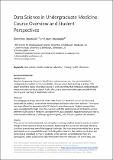Files in this item
Data science in undergraduate medicine : course overview and student perspectives
Item metadata
| dc.contributor.author | Doudesis, Dimitrios | |
| dc.contributor.author | Manataki, Areti | |
| dc.date.accessioned | 2022-12-20T00:41:18Z | |
| dc.date.available | 2022-12-20T00:41:18Z | |
| dc.date.issued | 2022-03 | |
| dc.identifier | 277182463 | |
| dc.identifier | b4cca7cb-e2cb-4a5a-a180-eb6035b7f216 | |
| dc.identifier | 85122708664 | |
| dc.identifier | 000788794900007 | |
| dc.identifier.citation | Doudesis , D & Manataki , A 2022 , ' Data science in undergraduate medicine : course overview and student perspectives ' , International Journal of Medical Informatics , vol. 159 , 104668 . https://doi.org/10.1016/j.ijmedinf.2021.104668 | en |
| dc.identifier.issn | 1386-5056 | |
| dc.identifier.other | RIS: urn:05E2150D9EFE51A694345DDAC7D3F2E8 | |
| dc.identifier.other | ORCID: /0000-0003-3698-8535/work/105318670 | |
| dc.identifier.uri | https://hdl.handle.net/10023/26627 | |
| dc.description | The authors would like to thank the Usher Institute at the University of Edinburgh for funding this work through an Usher Education Development Grant. | en |
| dc.description.abstract | Background Despite the growing interest in health data science education, it is not embedded in undergraduate medical curricula and little is known about best teaching practices. This paper presents a highly innovative course in a UK university that introduces undergraduate medical students to data science. It also discusses a study on student perspectives on the learning and teaching of health data science. Methods The pedagogical design elements of the Data Science in Medicine course are discussed, along with its syllabus, assessment methodology and flipped classroom delivery. The course has been offered to approximately 630 students over three years. Student perspectives were investigated through three focus groups with the participation of 19 students across different study years in medicine. An experiment was conducted regarding instructor-led vs. video-based modalities of online programming labs, with the participation of 8 students. Results The course has led to improved data competency among medical students and to a positive change in their opinions about data science. Motivating the course and showing relevance to clinical practice was one of the biggest challenges. Statistics was perceived by focus group participants as an essential data skill. Including data science in the medical curriculum was perceived as important by Year 1 students, while opinions varied between Year 4/5 participants. Video-based online labs were preferred over instructor-led online labs, and they were found to be more useful and enjoyable, without leading to any significant difference in academic performance. Conclusions Teaching data science to undergraduate medicine students is highly desirable and feasible. We recommend including statistics in the curriculum and practical skill development through simple and clinically-relevant data science tasks, supported through video-based online labs. Further reporting on similar courses is needed, as well as larger-scale studies on student perspectives. | |
| dc.format.extent | 7 | |
| dc.format.extent | 1953549 | |
| dc.language.iso | eng | |
| dc.relation.ispartof | International Journal of Medical Informatics | en |
| dc.subject | Data science | en |
| dc.subject | Health | en |
| dc.subject | Medicine | en |
| dc.subject | Education | en |
| dc.subject | Training | en |
| dc.subject | Health informatics | en |
| dc.subject | LB2300 Higher Education | en |
| dc.subject | QA75 Electronic computers. Computer science | en |
| dc.subject | R Medicine | en |
| dc.subject | ZA4450 Databases | en |
| dc.subject | DAS | en |
| dc.subject | AC | en |
| dc.subject.lcc | LB2300 | en |
| dc.subject.lcc | QA75 | en |
| dc.subject.lcc | R | en |
| dc.subject.lcc | ZA4450 | en |
| dc.title | Data science in undergraduate medicine : course overview and student perspectives | en |
| dc.type | Journal article | en |
| dc.contributor.institution | University of St Andrews. School of Computer Science | en |
| dc.identifier.doi | https://doi.org/10.1016/j.ijmedinf.2021.104668 | |
| dc.description.status | Peer reviewed | en |
| dc.date.embargoedUntil | 2022-12-20 |
This item appears in the following Collection(s)
Items in the St Andrews Research Repository are protected by copyright, with all rights reserved, unless otherwise indicated.

